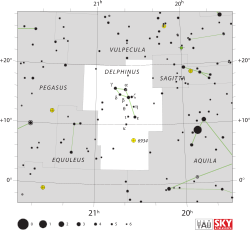Eta Delphini
| Eta Delphini (η) | |
 | |
| Observationsdata Epok: J2000.0 | |
|---|---|
| Stjärnbild | Delfinen |
| Rektascension | 20t 33m 57,04099s[1] |
| Deklination | +13° 01′ 38,1437″[1] |
| Skenbar magnitud () | +5,38[2] |
| Stjärntyp | |
| Spektraltyp | A3 IVs[3] |
| U–B | +0,05[2] |
| B–V | +0,08[2] |
| Astrometri | |
| Radialhastighet () | -25,00 ± 4,2[4] km/s |
| Egenrörelse (µ) | RA: +73,15[1] mas/år Dek.: +24,66[1] mas/år |
| Parallax () | 13,81 ± 1,17[1] |
| Avstånd | 240 ± 20 lå (72 ± 6 pc) |
| Absolut magnitud () | 1,11[5] |
| Detaljer | |
| Massa | 2,12[6] M☉ |
| Radie | 2,2[7] R☉ |
| Luminositet | 35[8] L☉ |
| Temperatur | 9 355 ± 318[6] K |
| Metallicitet | +0,56[5] dex |
| Vinkelhastighet | 65[8] km/s |
| Ålder | 309[6] miljoner år |
| Andra beteckningar | |
| η Del, 3 Delphini, BD+12° 4378, GC 28617, HD 195943, HIP 101483, HR 7858, SAO 106248[9] | |
Eta Delphini (η Delphini, förkortat Eta Del, η Del) är en dubbelstjärna[10] belägen i den mellersta delen av stjärnbilden Delfinen. Den har en skenbar magnitud på 5,38[2], är svagt synlig för blotta ögat där ljusföroreningar ej förekommer. Baserat på parallaxmätning inom Hipparcosuppdraget på ca 13,8[1] mas, beräknas den befinna sig på ett avstånd på ca 240 ljusår (ca 72 parsek) från solen. Stjärnan rör sig i riktning mot solen med en radiell hastighet av ca -25 km/s.[4]
Egenskaper
[redigera | redigera wikitext]Primärstjärnan Eta Delphini A är en blå till vit underjättestjärna av spektralklass A3 IV:s[3] med smala absorptionslinjer i dess spektrum.[11] Den misstänks vara en kemiskt ovanlig stjärna[12] som har fullgjort ca 64,3 ± 9,2 procent av dess väg på huvudserien.[8] Stjärnan har en beräknad massa som är ca 2,1[6] gånger större än solens massa, en radie som är ca 2,2[7] gånger större än solens och utsänder från dess fotosfär ca 35[8] gånger mera energi än solen vid en effektiv temperatur av ca 9 400[6] K.
Eta Delphini är en astrometrisk dubbelstjärna och SIMBAD listar den som en variabel stjärna,[9] även om den inte är katalogiserad som sådan i General Catalogue of Variable Stars.[13]
Referenser
[redigera | redigera wikitext]- Den här artikeln är helt eller delvis baserad på material från engelskspråkiga Wikipedia, tidigare version.
Noter
[redigera | redigera wikitext]- ^ [a b c d e f] van Leeuwen, F. (2007), "Validation of the new Hipparcos reduction", Astronomy and Astrophysics, 474 (2): 653–664, arXiv:0708.1752, Bibcode:2007A&A...474..653V, doi:10.1051/0004-6361:20078357.
- ^ [a b c d] Feinstein, A. (1974), "Photoelectric UBVRI observations of AM stars", Astronomical Journal, 79: 1290, Bibcode:1974AJ.....79.1290F, doi:10.1086/111675.
- ^ [a b] Cowley, A.; et al. (April 1969), "A study of the bright A stars. I. A catalogue of spectral classifications", Astronomical Journal, 74: 375–406, Bibcode:1969AJ.....74..375C, doi:10.1086/110819.
- ^ [a b] Gontcharov, G. A. (November 2006), "Pulkovo Compilation of Radial Velocities for 35495 Hipparcos stars in a common system", Astronomy Letters, 32 (11): 759–771, arXiv:1606.08053, Bibcode:2006AstL...32..759G, doi:10.1134/S1063773706110065.
- ^ [a b] Anderson, E.; Francis, Ch. (2012), "XHIP: An extended hipparcos compilation", Astronomy Letters, 38 (5): 331, arXiv:1108.4971, Bibcode:2012AstL...38..331A, doi:10.1134/S1063773712050015.
- ^ [a b c d e] David, Trevor J.; Hillenbrand, Lynne A. (2015), "The Ages of Early-Type Stars: Strömgren Photometric Methods Calibrated, Validated, Tested, and Applied to Hosts and Prospective Hosts of Directly Imaged Exoplanets", The Astrophysical Journal, 804 (2): 146, arXiv:1501.03154, Bibcode:2015ApJ...804..146D, doi:10.1088/0004-637X/804/2/146
- ^ [a b] Pasinetti Fracassini, L. E.; et al. (February 2001), "Catalogue of Apparent Diameters and Absolute Radii of Stars (CADARS)", Astronomy and Astrophysics (Third ed.), 367: 521–524, arXiv:astro-ph/0012289, Bibcode:2001A&A...367..521P, doi:10.1051/0004-6361:20000451.
- ^ [a b c d] Zorec, J.; Royer, F. (January 2012), "Rotational velocities of A-type stars. IV. Evolution of rotational velocities", Astronomy & Astrophysics, 537: A120, arXiv:1201.2052, Bibcode:2012A&A...537A.120Z, doi:10.1051/0004-6361/201117691.
- ^ [a b] "eta Del". SIMBAD. Centre de données astronomiques de Strasbourg. Hämtad 2017-08-18.
- ^ Eggleton, P. P.; Tokovinin, A. A. (September 2008), "A catalogue of multiplicity among bright stellar systems", Monthly Notices of the Royal Astronomical Society, 389 (2): 869–879, arXiv:0806.2878, Bibcode:2008MNRAS.389..869E, doi:10.1111/j.1365-2966.2008.13596.x.
- ^ Allen, J. S., "The Classification of Stellar Spectra", Department of Physics and Astronomy: Astrophysics Group, University College London, hämtad 1 januari 2014.
- ^ Renson, P.; Manfroid, J. (May 2009), "Catalogue of Ap, HgMn and Am stars" (PDF), Astronomy and Astrophysics, 498 (3): 961–966, Bibcode:2009A&A...498..961R, doi:10.1051/0004-6361/200810788.
- ^ Samus, N. N.; et al. (2017), "General Catalogue of Variable Stars", Astronomy Reports, GCVS 5.1, 61 (1): 80–88, Bibcode:2017ARep...61...80S, doi:10.1134/S1063772917010085.
Externa länkar
[redigera | redigera wikitext]
| |||||||||||||||||||





